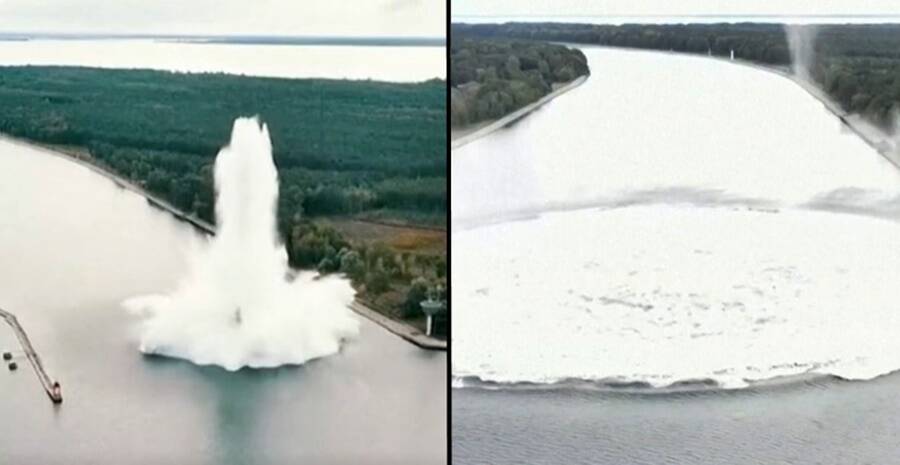Luckily, nobody was hurt when the decades-old bomb went off.

Polish NavyA “Tallboy” bomb from World War II found in Poland accidentally detonated during an attempt to diffuse it.
Last year, authorities in Poland discovered an unnerving relic from World War II beneath the surface of the water: a massive unexploded bomb. Authorities tried to defuse the bomb, the largest of its kind ever found in Poland, only to have it go off anyway.
According to the BBC, the bomb was uncovered at a depth of 40 feet below the surface of the Baltic Sea right off the coast of Swinoujscie, a port city in Poland.
The bomb itself was more than 20-feet long and weighed 5.4 tons — and nearly half this weight was explosives. For context, that strong of an explosive is roughly equivalent to 3.6 tons of TNT.
It was one of the “earthquake bombs” of the Second World War, nicknamed “Tallboy” due to its intimidating size. According to one local historian, Tallboys were designed to explode underground next to a target and trigger shock waves that would destroy it.

Polish Navy Waves from the aftermath of the bomb’s explosion.
The decades-old explosive had been dropped by the Royal Air Force during an attack against a Nazi warship near Swinoujscie which was, back then, called Swinemünde as it was part of Germany.
The port city was home to one of the German Navy’s most important bases in the Baltic Sea. Thus, it saw plenty of bombing attempts from Allied forces.
When the undetonated Tallboy was discovered in 2019, only the edge of the bomb’s “nose” had been visible, sticking out of the water.
Roughly 750 residents of the small town were evacuated by authorities before plans to defuse the unexploded device were carried out.
Poland’s Naval forces planned to use a remote-controlled device to try to “deflagrate” the bomb, which is a technique used to burn out the explosive charge without causing a detonation.
The Polish Navy had ruled out the more traditional method of a controlled explosion over concerns it would destroy a bridge located about 1,600 feet away from the bomb site.
But the deflagration didn’t go as planned. The remote-controlled deflagration set off the bomb, causing a large blast of water to rise from underneath.

Public DomainTallboy bombs were used to send shockwave attacks against targets during the war.
“The deflagration process turned into detonation,” said Lt Cmdr Grzegorz Lewandowski, spokesperson for the Polish Navy’s 8th Coastal Defence Flotilla which carried out the mission. “The object can be considered neutralized, it will not pose any more threat to the Szczecin-Swinoujscie shipping channel.”
Fortunately, nobody was injured when the bomb went off, including all the Naval divers who had been underwater during the deflagration of the bomb. There was no damage to any nearby structures or buildings either, despite initial fears that an explosion could lead to infrastructural damage around the site.
While finding an undetonated bomb left over from the war may seem like a shocking event, it is quite a common occurrence around Europe.
In Germany, especially, discovering unexploded bombs from World War II happens frequently enough that bomb sweeping has become standard procedure before construction projects are begun.
According to historian Jens Wehner, somewhere between 1.3 and 1.4 million bombs were dropped on Germany’s territory during World War II — and around 10 percent of them never exploded. It is hard to estimate how many unexploded bombs are left during modern times today.
When authorities do find these hidden bombs, however, it becomes a public ordeal, particularly when the bomb is uncovered in a densely-populated area. In 2017, a massive 4,000-pound unexploded ‘blockbuster’ bomb was found in the metropolis of Frankfurt, leading to the evacuation of 70,000 or about 10 percent of the city’s residents.
Nevertheless, experts say that the risk of being hit by an unexploded bomb is much lower than being struck by lightning. Let’s hope nobody has to endure either.
Next, read about the unexploded WWII-era bombs dropped by the U.S. Army found on a Hawai’ian volcano and learn about the reckless man in Slovenia who found an undetonated war bomb — then took it home with him.





